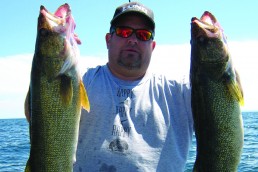Big Walleyes Head East in Summer
SHARE THIS POST
If you’re looking to catch some nice walleyes in Lake Erie this summer, John Hageman says your best bet is to fish the eastern portion of the lake.
When given a choice, walleyes prefer water temperatures below the low 70s. Since the Western Basin of Lake Erie typically reaches a surface temperature of nearly 80 F during many summers, most of the larger fish migrate to the cooler waters to the east after spawning on the reefs or up the rivers.
While 80 F is not high enough to kill them outright, according to fisheries biologists, it makes them uncomfortable and very inefficient users of their prey. Quite simply, their metabolisms burn calories faster than prey can be consumed.
While some linger in the waters off Huron or Vermilion, just east of Kelleys Island, acoustic tagging studies are now showing that some go all the way to New York!
Although the gap is likely narrowing with the increased popularity of early-season fishing, Ohio Division of Wildlife creel surveys have long shown that more walleyes are harvested in the Central Basin on a busy July weekend than in a month of fishing in April over the reefs.
But, because larger walleyes prefer cooler water and are mostly females, they often make up 80 percent of the Central Basin summer daily bag limits and a good share of the fall harvest, too. This observation is why the annual calls to close the walleye fishing season around the spring spawning period falls on deaf ears of our state’s fisheries biologists, who manage using sound science.
Consider this: If a female walleye gets tossed in the cooler in July or August, she will not spawn during the next season, either—just like ones boxed in March or April. So why reduce spring fishing opportunities for a resource that continues to grow in size and numbers?
Are you enjoying this post?
You can be among the first to get the latest info on where to go, what to use and how to use it!
More eggs do not translate into more walleyes in the cooler a couple of years later. Fry survival rates are the primary factor that determines recruitment size and is related to weather and the timing of plankton blooms, not fishing pressure.
The odds are better for more and bigger fish, but it is does not mean that all walleye fishermen must go east. A small subset of the trophy-size walleye population remains in locations where currents from the Detroit River carry cooler water from Lake Huron, especially on island area rock piles where round gobies are plentiful and easy prey, and on the Canadian side of the lake when accessible.
Smaller walleyes can tolerate the warm conditions better, and more of this population than bigger ones take advantage of the immense schools of young-of-year fish species pouring from the tributary streams and feeding in the rich, nearshore zone coastline.
The catch in the summer is often made up of very healthy-looking 14- to 18-inch walleyes stuffed with emerald shiners, gizzard shad, white bass, white perch, freshwater drum or rainbow smelt, depending upon what is available.
Recently, 2-year-old walleyes have been reaching the legal 15-inch keeper size weeks earlier in the summer. This may be because their diet also includes mayfly larvae throughout the summer, even after their peak emergence in mid- to late June. Mayflies have been shown to be a big factor that helps drive their fast growth rates.
Want to try fishing a new location this year? You’ll find plenty of suggestions in every issue of MidWest Outdoors, available by subscribing on our website.
MWO
SHARE THIS POST
You may also like...
Nothing found.
Did you enjoy this post?
You can be among the first to get the latest info on where to go, what to use and how to use it!
John Hageman
John Hageman was manager of Stone Laboratory, Ohio Sea Grant's Biology Station at Put-in-Bay, for 25 years and formerly a licensed Lake Erie ice-fishing guide. He is active with the Outdoor Writers of Ohio and several sportsmen's conservation organizations. He may be contacted at hageman.2@osu.edu.
